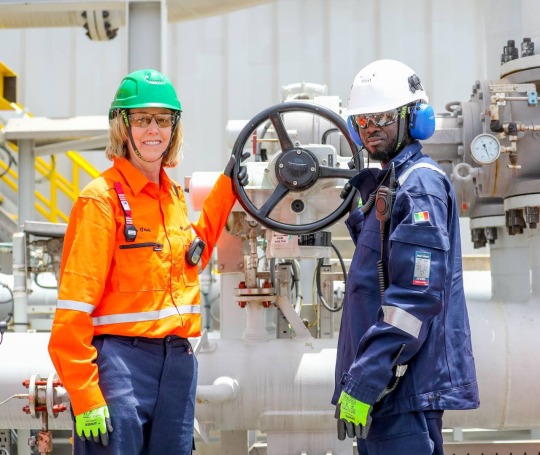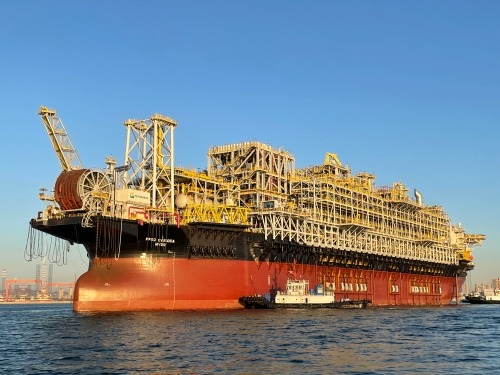#fpso
Explore tagged Tumblr posts
Text
Campo de Búzios bate recorde e atinge produção de 800 mil barris de petróleo por dia
O Campo de Búzios, situado na área do pré-sal da Bacia de Santos, a aproximadamente 180 quilômetros da costa do Rio de Janeiro, alcançou nesta segunda-feira (24/2) um marco histórico: a produção de 800 mil barris de petróleo por dia. O campo, que começou a operar em 2018, consolida-se como o segundo maior produtor de petróleo do Brasil, ficando atrás apenas do Campo de Tupi. Recorde O recorde foi…
#Brasil#800 mil barris de petróleo por dia#Bacia de Santos#Campo de Búzios#FPSO#maior produtor de petróleo#marco histórico#plataforma Almirante Tamandaré#pré-sal#produção
0 notes
Text
Bumi Armada Berhad: Results in line despite forex headwinds
Bumi Armada’s 9MFY24 core net profit of RM766.8m met expectations despite forex headwinds. 3QFY24 saw a 0.6% qoq dip due to weaker USD/MYR and increased expenses. YoY, profits surged 41.2%, supported by higher revenue and lower finance costs. Debt refinancing and stronger USD outlook improve prospects. Maintain BUY at RM0.76. Bumi Armada key highlights 9MFY24 Core Net Profit: RM766.8m, meeting…
0 notes
Text

Improving Vessel Performance and Profitability with Variable Frequency Drives (VFDs)
Cut your energy consumption on fans, pumps and compressors by as much as 60% when integrating VFDs. The IP55/NEMA12 and IP66/NEMA4X rated enclosures for the Optidrive P2 High Performance series are ready to operate in marine environments straight out of the box with no additional enclosures required.
For your onboard winches, the Optidrive P2 features Auto Tension Control which maintains the correct level of winch tension in all operating conditions. The VFDs provide precise and responsive control of thruster systems, enhancing the vessel maneuverability. VFDs will also significantly reduce the maintenance costs associated with hydraulic oil leakages and oil change.
The VFD Exchange
#vfd#variablefrequencydrives#inverter#acdrives#thrustercontrol#wheelhousecontrol#electrical#controls#automation#marine#maritime#ships#fpso#fso#thrusters#winches#crane#hoist#pump#compressor#fans#hvac#engineering#vfds#variablefrequencydrive#acmotors#invertek#optidrive#ams#pms
0 notes
Text
Sénégal : Visite du Président Bassirou Diomaye FAYE sur le FPSO Léopold Sédar Senghor
Le Président de la République, Bassirou Diomaye Faye, s’est rendu aujourd’hui sur le champ pétrolier de Sangomar, situé à 100 km au large de Dakar, pour constater l’état d’avancement des travaux de production sur le FPSO Léopold Sédar Senghor. Cette visite marque une étape cruciale dans le développement du secteur pétrolier sénégalais, avec la première phase de production en pleine expansion et…

View On WordPress
0 notes
Text
Top 7 Upcoming FPSO Projects in the World
The demand for Floating Production Storage and Offloading (FPSO) units is on the rise driven by more investments and increased production in the offshore oil and gas industry. Unlike traditional seabed pipelines, modern FPSOs offer a cost-effective solution with reduced maintenance costs over time, making them an increasingly attractive option for companies operating in this sector.
0 notes
Text
Navigating the Future: Floating Production, Storage, and Offloading Market Trends
Floating production storage and offloading market is an offshore production facility that consists of processing equipment and storage for produced hydrocarbons. In the storage facility, oil is stored and handled until it is moved to a big tanker for refining and transporting. It is a floating vessel that is a converted oil big hauler, which is similar to a ship, equipped with production and handling facilities onboard. Furthermore, oil & gas from FPSO is transported to onshore through a big hauler in vessels. These vessels are utilized to extricate or get crude hydrocarbons from ocean beds, which are then handled in locally available preparing facilities.
COVID-19 scenario analysis:
Transportation limitations and stringent government policies toward limited movement of vehicles cause a downturn in the FPSO market in the midst of the COVID-19 pandemic.
Oil companies face problems such as halting of production and decline in oil prices. The U.S. oil prices went negative for the first time in history of the oil industry. For instance, in May, 2020, traders were paying customers to buy oil in the U.S., which imbalanced the oil market, thereby negatively impacting the market growth.
Implementation of lockdown and social distancing norms are expected to delay many oil & gas projects, including complex deep-sea projects that rely on labor and material from across the globe to processing plant extension and pipe-laying.
Top impacting factors: Market scenario analysis, trends, drivers, and impact analysis
The FPSO market size is expected to observer vigorous development, owing to increase in focus on offshore exploration and production activities and rise in exploration in deep & ultra-deep-water. As per the International Energy Agency (IEA), yearly capital spending toward offshore oil & gas production exercises is estimated to grow significantly, thereby positively impacting the market growth. In addition, exhausting onshore oil reserves support the organizations of FPSOs. However, the adoption of FPSO systems has declined due to decrease in prices of oil & gas.
Increase in exploitation activities of marginal oil reserves at remote offshore areas combined with the capacity of FPSOs to work without a fixed structure support are anticipated to have a positive impact on the market development. For example, in 2018, an oil field was found in North Western Shelf of Australia. Furthermore, capability of such units to withstand extreme weather conditions is expected to boost the market growth.
Expansion analysis across various regions
North America and the Middle East are the major undiscovered areas, which have negligible quantities of FPSOs and are expected to offer remunerative opportunities for the expansion of the FPSO market in the coming years. North America and Europe hold considerable market share and are expected to witness steady growth in the next few years due to increase in number of oil & gas reserves.
Brazil is anticipated to serve as a lucrative market for FPSOs, owing to increase in oil & gas exploration activities along with adequate government support toward the development of upstream operations, including energy and power. Presence of shallow water oil & gas fields in China, Indonesia, & India and presence of ultra-deep ocean reserves in these areas are evaluated to offer lucrative opportunities over the forecast timeframe for new production storage and offloading market.
Key benefits of the report
This study presents the analytical depiction of the FPSO market along with the current trends and future estimations to determine the imminent investment pockets.
The report presents information related to key drivers, restraints, and opportunities along with detailed analysis of the FPSO market share.
The current market is quantitatively analyzed to highlight the FPSO market growth scenario.
Porter’s five forces analysis illustrates the potency of buyers & suppliers in the market.
The report provides a detailed analysis depending on competitive intensity and how the competition will take shape in coming years.
0 notes
Text
civil engineering internship in india
cyber security internship in india data analysis internship in india https://3d-labs.com/internship-training/ Exciting Opportunity for Students Worldwide We at 3D-LABS are thrilled to announce our Global Internship Training Program in Engineering Design and IT Solutions! Don't miss this chance to elevate your career! Learn more and apply today. 3DLABS #InternshipProgram #EngineeringDesign #ITTraining #3D #CareerDevelopment #GlobalOpportunity.

#fpso engineering nternship in india#computer tech internship in india#web designing internship in india
0 notes
Text
NCDMB Boss Advocates Local Patronage During Visits to Samsung and Africoat Facilities
The Executive Secretary of the Nigerian Content Development and Monitoring Board (NCDMB), Engr. Felix Omatsola Ogbe, recently visited the premises of Samsung Heavy Industries Nigeria (SHIN) and Africoat Nigeria Limited, a pipe coating facility located in Takwa Bay, Lagos. This visit aligns with his commitment to evaluating oil and gas facilities nationwide, ensuring their participation in current…
#Africoat Nigeria#FPSO Integration#Local Content Development#NCDMB#Nigerian Oil and Gas#Oil and Gas Projects#Samsung Heavy Industries
0 notes
Text
https://www.baxcell.com/About%20Us.html
infrastructure comprising of modern machines
At BAXCELL, our inherent strength is our infrastructure comprising of modern machines & our team of engineers, supervisors, workers and staff who are constantly striving to excel in their respective departments. The company is lead by a team of dedicated Technocrats, Engineers & Professionals with more than 25 years in the field.
0 notes
Text
Nigeria will produce more crude oil when Shettima launches a $315 million FPSO in Dubai.
Nigeria’s crude oil production will rise by 30,000 barrels per day (bpd) as Vice President Kashim Shettima inaugurated Oriental Energy Resources Limited’s $315 million Floating Production, Storage and Offloading (FPSO) vessel to boost Nigeria’s oil production capacity. The FPSO vessel, with a storage capacity of one million barrels, which will kick off with an initial production of 17,000 barrels…
0 notes
Text
Heat Exchangers Manufacturer for Floating Production Storage and Offloading (FPSO)
Heat Exchangers Manufacturer for Floating Production Storage and Offloading (FPSO)
A mechanical device called a heat exchanger is used to move heat, or thermal energy, between two or more fluids that are at different temperatures. Effectively exchanging heat from a hotter to a cooler fluid, or vice versa, without letting the two fluids mix, is the goal of a heat exchanger. This thermal energy transfer is widely employed in daily applications as well as industrial operations for a variety of functions, such as heating, cooling, condensation, and evaporation. Heat exchangers are essential components of Floating Production, Storage, and Offloading (FPSO) systems because of the particular difficulties associated with offshore oil and gas operations. Heat exchangers are necessary for FPSOs for the following reasons:
Facilities for processing hydrocarbons, such as natural gas and crude oil, that are drawn from offshore wells are installed on FPSOs. Heat exchangers play a critical role in processes like treating and separating hydrocarbon streams, condensing vapours, and regulating temperature at different stages of processing. Temperature control is essential to FPSO operation efficiency. In order to maintain the ideal range for processing and storage conditions, heat exchangers assist in controlling the temperature of process fluids. For more please visit https://watermanaustralia.com/designing-heat-exchangers-for-floating-production-storage-and-offloading-fpso/
0 notes
Link
0 notes
Photo

Eni's African exploration had been nothing short of extraordinary. In less than two years since the discovery of the oil & gas field, the company had turned it into a production powerhouse. Yet, beneath the impressive achievement lurked a mysterious aura. Even the most seasoned of explorers found it hard to comprehend the speed of the transformation. Was it just skill, or was there something more? Was the field, with its ancient secrets, somehow drawing on Eni's strength and knowledge to yield such a swift result? Nobody could say for sure. All anyone knew was that amidst the heat and the dust, something strange and powerful was stirring.
0 notes
Text
Sénégal – Mauritanie : Le FPSO est arrivé sur le champ GTA
Le FPSO, unité essentielle dans le traitement initial du gaz, joue un rôle crucial dans la séparation de ce dernier des autres substances co-extraites, telles que l’eau et le condensat. Cette fonction s’avère être une composante vitale dans le processus de développement du champ gazier Grand Tortue Ahmeyim (GTA). La société nationale sénégalaise Petrosen a annoncé l’arrivée de l’Unité Flottante…

View On WordPress
0 notes
Text
Podcast Summary
Noble NE 0.00%↑ retiring a couple drillships, and why parts of the stacked fleet will continue to be retired.
Why higher spec stacked drillships are more likely to be reactivated.
Why he thinks Transocean RIG -0.52%↓ has the highest quality active fleet.
The Transocean & Seadrill SDRL 0.00%↑ M&A rumors, and future consolidation of the sector.
How the offshore bull cycle has been delayed, the picture for 2025/2026, and where day rates have to go to see new builds.
His thoughts on jackups, Borr Drilling BORR 0.00%↑, and their asset quality.
The OSV market, Tidewater TDW 0.00%↑, and how OSVs will benefit from increased activity in the deepwater sector.
Why he finds FPSOs (Floating Production Storage Offloading units) interesting.
Namibia, Colombia, and Suriname as potential geographies for new long-term drillship demand.
Book Recommendation: Chip War by Chris Miller.
4 notes
·
View notes
Text
Brazil sees monthly increase in oil & gas production, with lion’s share coming from Petrobras’ offshore fields
The Brazilian National Agency for Petroleum, Natural Gas, and Biofuels (ANP) has published its monthly oil and natural gas production bulletin for August 2024, comprising consolidated data on national production.

Based on the data reported, the combined oil and gas production amounted to 4.345 million barrels of oil equivalent per day (boe/d) in August, with 3.340 million barrels per day (bbl/d) of oil extracted, an increase of 3.4% compared to July, but a drop of 3.5% compared to the same month in 2023.
Natural gas production reached 159.7 million cubic meters per day (m³/d), increasing 5.6% compared to July 2024 and 8% compared to August 2023. The use of natural gas was 97.8%, with 54.33 million m³/d made available to the market. Flaring reached 3.61 million m³/d, representing a 6.8% increase compared to July, but a 4.3% decrease compared to last August.
Regarding Brazil’s pre-salt, the combined oil and gas production amounted to 3.463 million boe/d, making up 79.7% of the country’s production, which is a 5.5% increase compared to both the previous month and the same period last year. The ANP’s data shows that 2.694 million bbl/d of oil and 122.25 million m³/d of natural gas were produced through 148 wells.
The Tupi field, situated in the pre-salt area of the Santos Basin, was the largest producer, with 832,600 thousand bbl/d of oil and 43.19 million m³/d of natural gas produced in August. The installation with the highest production was the floating production, storage, and offloading (FPSO) unit Carioca (Mv-30), operating in the Sépia, Sépia Leste, and Sépia Eco fields, accounting for 160,720 bbl/d of oil.
Continue reading.
2 notes
·
View notes